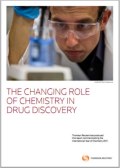 Almost any skilled organic chemist could create novel variations on the solid form, polymorphs, of small molecules currently used as pharmaceuticals. This represents a problem for manufacturers of generic drugs because big pharma attempts to extend the patent lifespan of its well-known products by adding such polymorphs to the patent.
Almost any skilled organic chemist could create novel variations on the solid form, polymorphs, of small molecules currently used as pharmaceuticals. This represents a problem for manufacturers of generic drugs because big pharma attempts to extend the patent lifespan of its well-known products by adding such polymorphs to the patent.
Prasad Vure of Indian generics company Dr. Reddy’s Laboratories Ltd is concerned that the extended protection offered to the pioneer companies by polymorphs does not represent any significant scientific advance in medicine but is simply a way to stifle generic competition in the pharmaceutical market.
Dr Reddy’s manufacturers 190 medications, 60 active pharmaceutical ingredients for drug manufacture, diagnostic kits, critical care, and biotechnology products. The name may be rather familiar to anyone who has, for instance, received a prescription for an established medication under the UK National Health Service recently, as physicians are increasingly encouraged to opt for the generic prescription rather than the commonly more expensive proprietary drug for their patients. The issue of polymorphs and the patent extensions to expensive, original medications they might afford could preclude such generic savings across the NHS and in other parts of the world.
Pioneers, polymorphs and generic pharmaceuticals
“Pharmaceuticals can exist in various solid forms include ‘true polymorphs’, solvates, desolvates and amorphous solids,” explains Vure. He adds that screening of pharmaceuticals early on in drug discovery to find out all possible solid forms has significant connotations because the ‘wrong’ polymorph formed at the crystallisation stage can be far less effective than another and occasionally even toxic because it is absorbed at an inappropriate rate by the body and/or metabolised ineffectively. He points out that pioneer companies, those who first create the pharmaceutical product widely claim that patent claims for novel crystal forms is an important component of their intellectual property position, but that it significantly delays the entry of generic versions of drugs once original patents expire and so stifles the free market.
“There are numerous instances where innovator companies have acquired patents on a particular polymorphic form,” says Vure, “which extend beyond the expiry of basic molecule’s patent.” However, the converse can also benefit generics manufacturers briefly if they can obtain certification for a novel, active and safe polymorph of a patent-expired drug. Such a filing will give the generic manufacturer exclusive marketing rights for 180 days and a healthy market share ahead of other generic competition.
Polymorphic resonance
Success with a polymorph patent rests almost exclusively with the uniqueness of the X-ray diffraction pattern for the specific polymorph, if a pioneer company can demonstrate that a generic manufacturer is infringing on the basis of the XRD data then patents are usually upheld. Conversely, if a single peak is absent then the generic company can, rarely defeat the pioneer in court with the “novelty” of its polymorph. However, Vure points out that approximations in the XRD data blur the distinction between visible peaks and missing peaks more often than not in favour of the pioneer company rather than the generic manufacturer.
12 pioneering pharmaceuticals with polymorph patents
- Allegra (Fexofenadine) – Sanofi – Originally 1979, polymorph 1994
- Cozaar (Losartan) – Merck – Orig. 1986, poly 1993
- Clarinex (Desloratadine) – Schering-Plough – Orig. 1984, poly 1997
- Duricef (Cefadroxil) – Warner Chilcott – Orig. 1967, poly 1977
- Epivir (Lamivudine) – GlaxoSmithkline – Orig. 1989, poly 1992
- Geodon (Ziprasidone) – Pfizer – Orig. 1988, poly 1992
- Omnicef (Cefdinir) – Abbott – Orig. 1980, 1988
- Paxil (Paroxetine) – GlaxoSmithkline – Orig. 1974, poly 1986, 1995
- Pepcid (Famotidine) – Merck – Orig. 1979, poly 1987
- Valtrex (Valacyclovir) – GlaxoSmithkline – Orig. 1988, poly 1996
- Zantac (Ranitidine) – GlaxoSmithkline – Orig. 1977, poly 1981
- Zoloft (Sertaline) – Pfizer – Orig. 1979, poly 1992
You can read the introduction to my report for Thomson Reuters on The Changing Role of the Pharma Industry here and download the full report for free as a PDF.
![]() Prasad Vure (2011). Polymorph patents; how strong they are really? Int. J. Intellectual Property Management, 4 (4), 297-306
Prasad Vure (2011). Polymorph patents; how strong they are really? Int. J. Intellectual Property Management, 4 (4), 297-306
 As of 2011-12-01 the Sciencebase Science Blog will no longer be accepting comments on posts and pages nor in its guestbook. I have been running the site under the WordPress content management (CMS) platform for several years now, although the site has actually existed since July 1999 and in that time comment spam has grown considerably.
As of 2011-12-01 the Sciencebase Science Blog will no longer be accepting comments on posts and pages nor in its guestbook. I have been running the site under the WordPress content management (CMS) platform for several years now, although the site has actually existed since July 1999 and in that time comment spam has grown considerably. UPDATE: 28th November. It’s been a long, hard struggle, but finally after four weeks I have something on my upper lip that you might refer to as a “mo”, it’s unruly, asymmetric and littered with stray blonde hairs… I’m sure if I’d let the hair on my chin grow I’d look like Rip Van Winkel by now, but the tache task, the trivial pursuit of making the upper lip hirsute is the aim of Movember, and while I’m no Lech Walesa there is hair to be seen, so I updated the words to my Movember Blues…see below.
UPDATE: 28th November. It’s been a long, hard struggle, but finally after four weeks I have something on my upper lip that you might refer to as a “mo”, it’s unruly, asymmetric and littered with stray blonde hairs… I’m sure if I’d let the hair on my chin grow I’d look like Rip Van Winkel by now, but the tache task, the trivial pursuit of making the upper lip hirsute is the aim of Movember, and while I’m no Lech Walesa there is hair to be seen, so I updated the words to my Movember Blues…see below. The role of the drug discovery chemist has changed significantly over the past 50 years – workflows have been reinvented while the same goals remain to find and test novel molecules that can reach and act on disease targets.
The role of the drug discovery chemist has changed significantly over the past 50 years – workflows have been reinvented while the same goals remain to find and test novel molecules that can reach and act on disease targets. Your talk went down very well, you got rapturous applause, and some delegates even began to stand…there were murmurings of a Nobel Prize. Now, the hard bit, all those eager students in the front row want a copy of your slides so they can emulate your greatness, or more likely nitpick and point out the flaws in your otherwise flawless logic. You really don’t want the inconvenience of collecting email addresses or worse swapping business cards. So, what’s the easy option for a busy speaker one the conference circuit? QR codes. Obviously.
Your talk went down very well, you got rapturous applause, and some delegates even began to stand…there were murmurings of a Nobel Prize. Now, the hard bit, all those eager students in the front row want a copy of your slides so they can emulate your greatness, or more likely nitpick and point out the flaws in your otherwise flawless logic. You really don’t want the inconvenience of collecting email addresses or worse swapping business cards. So, what’s the easy option for a busy speaker one the conference circuit? QR codes. Obviously. Movember (as in moustache November) grows annually, it’s a month-long event started in 1999 in Adelaide, Australia. Since 2004, the Movember Foundation charity has run Movember events to raise awareness and funds for men’s health issues, such as prostate cancer and depression, in Australia and New Zealand. In 2007, events were launched in Ireland, Canada, Czech Republic, Denmark, Spain, the United Kingdom, Israel, South Africa, Taiwan and the United States. In 2010, Movember merged with the testicular cancer event Tacheback.
Movember (as in moustache November) grows annually, it’s a month-long event started in 1999 in Adelaide, Australia. Since 2004, the Movember Foundation charity has run Movember events to raise awareness and funds for men’s health issues, such as prostate cancer and depression, in Australia and New Zealand. In 2007, events were launched in Ireland, Canada, Czech Republic, Denmark, Spain, the United Kingdom, Israel, South Africa, Taiwan and the United States. In 2010, Movember merged with the testicular cancer event Tacheback.
 Schadenfreude: pleasure derived from another’s misfortune. Black humour. The hilarity experienced in watching a pratfall, the clumsy slip on a
Schadenfreude: pleasure derived from another’s misfortune. Black humour. The hilarity experienced in watching a pratfall, the clumsy slip on a